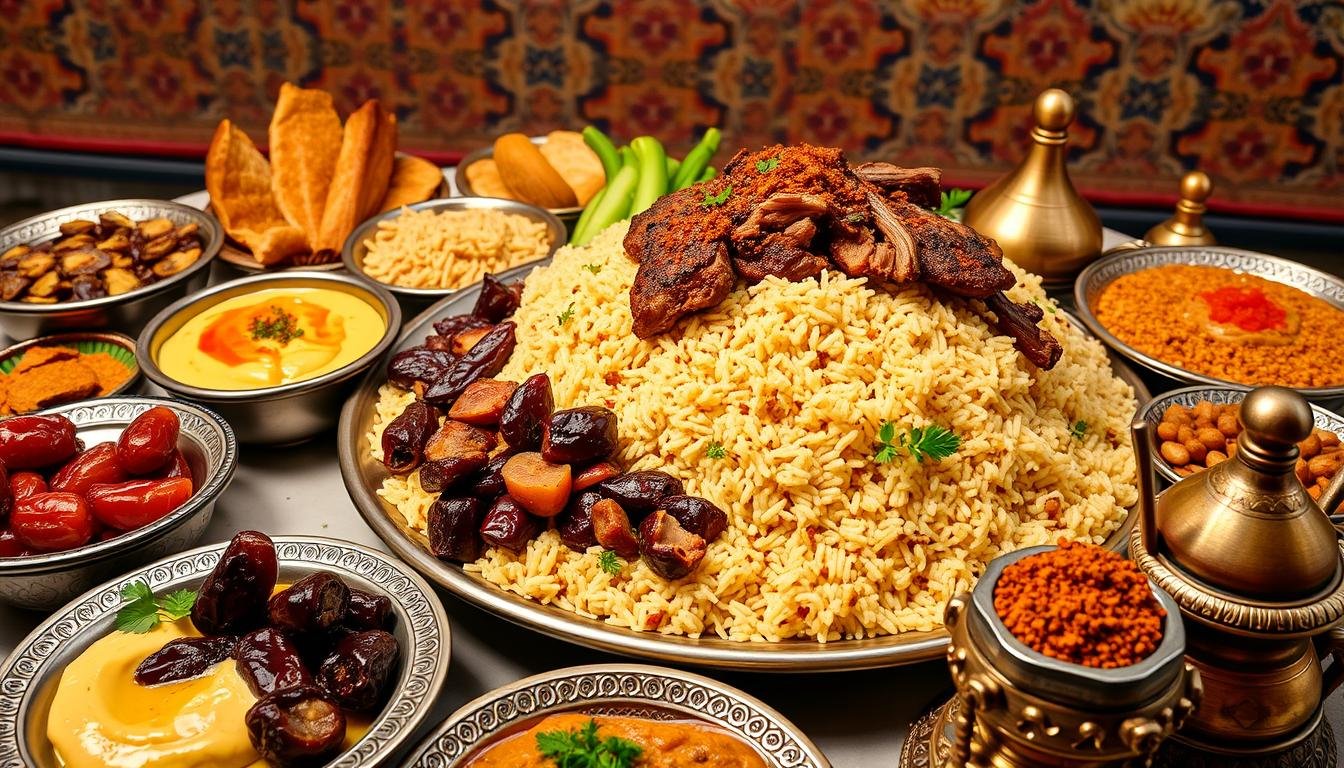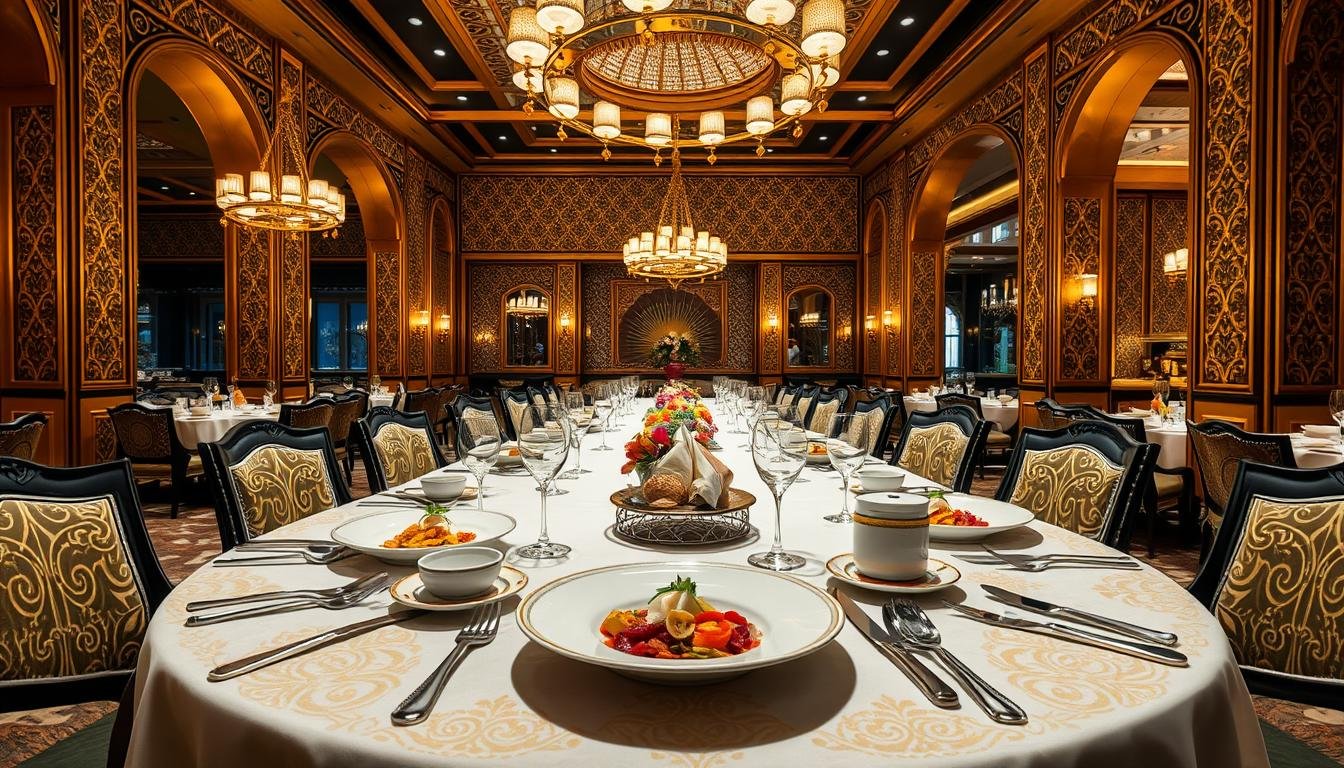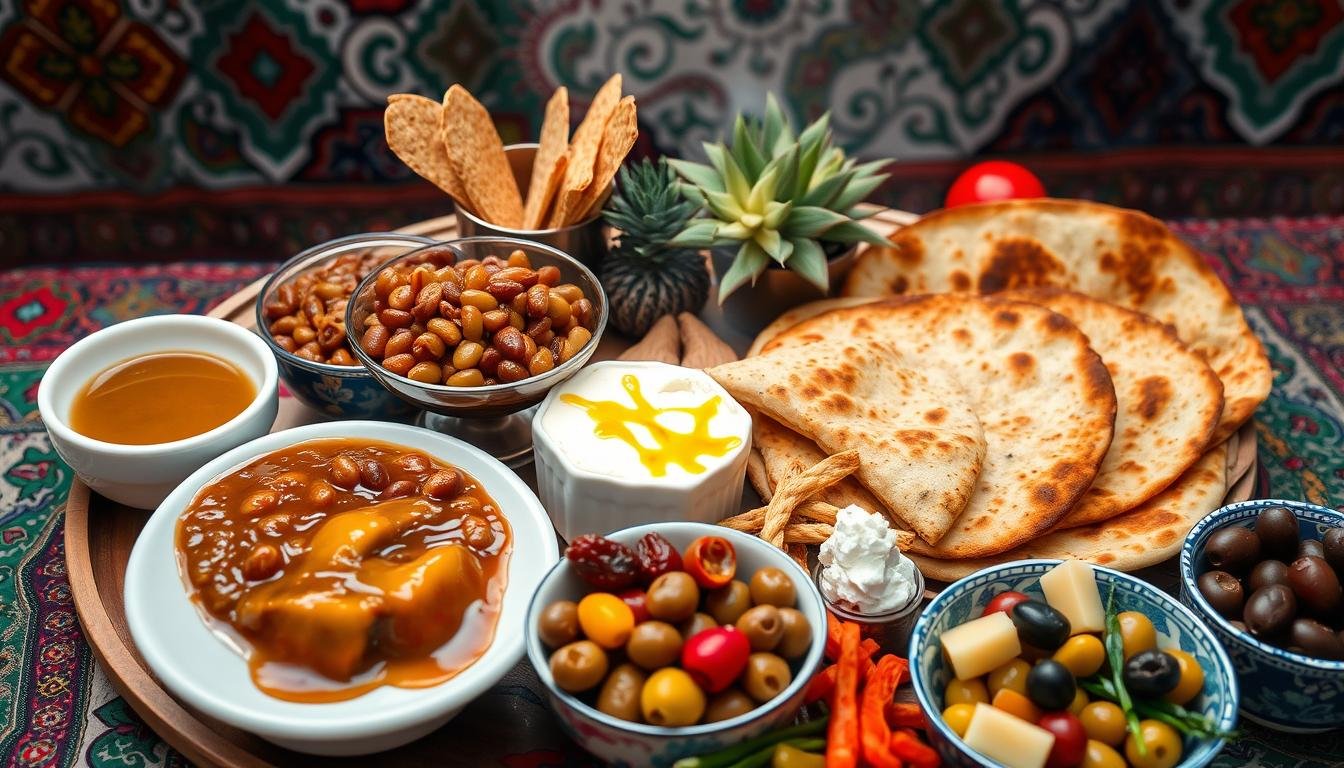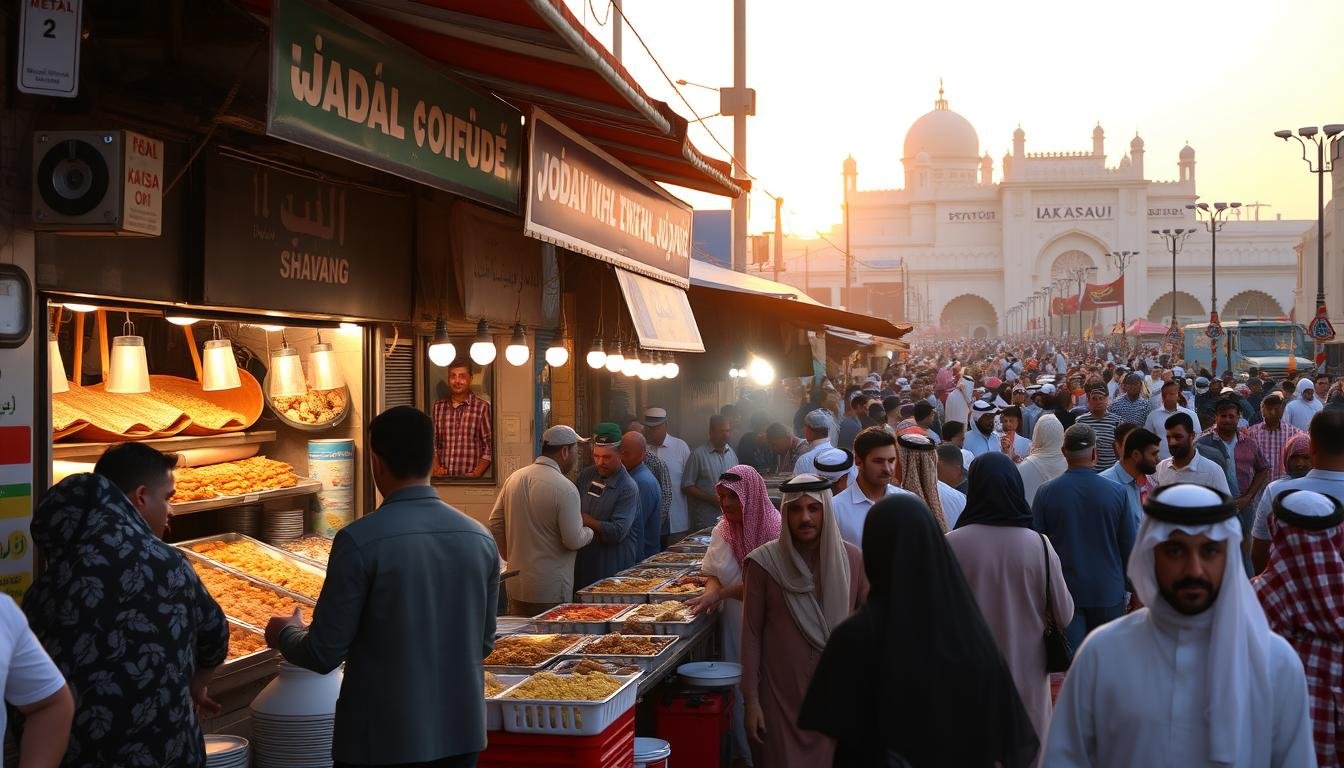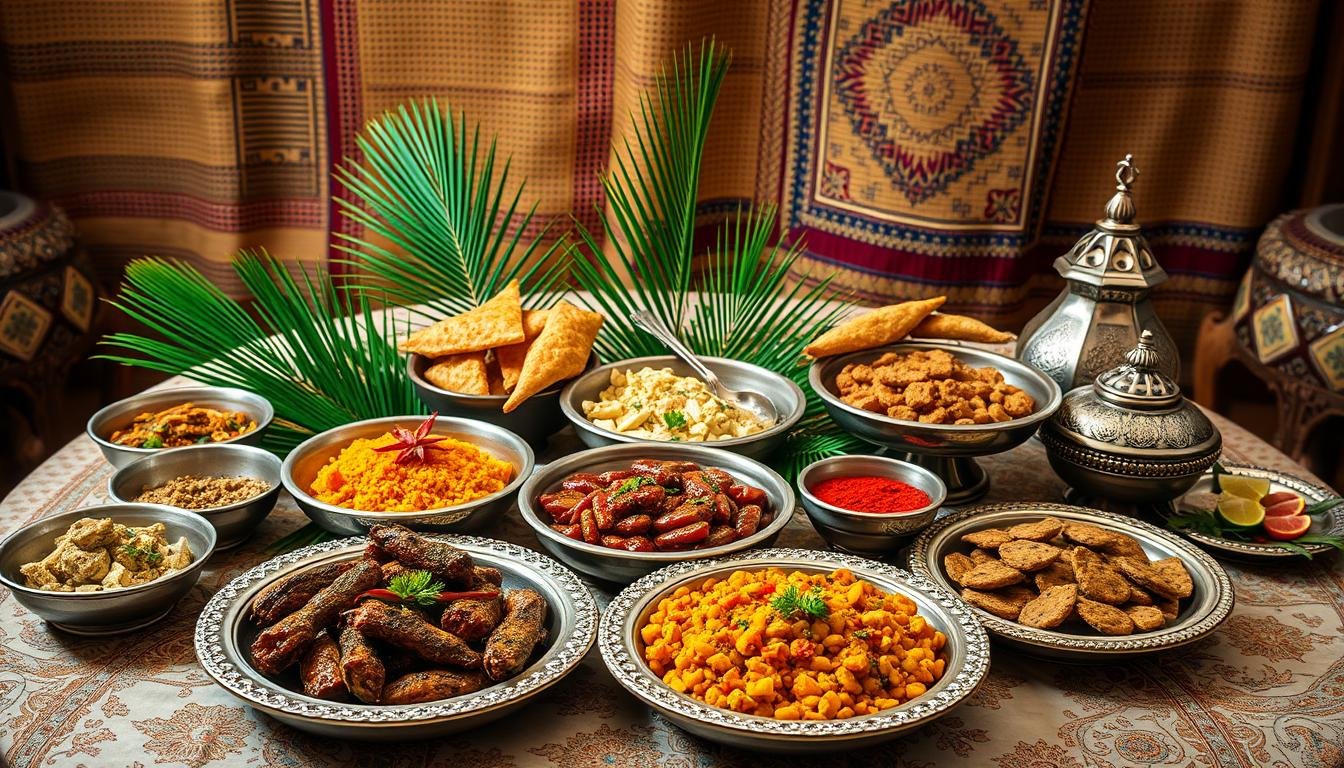For years, I’ve wondered: What hidden culinary gems lie within the rich tapestry of Saudi Arabian cuisine? The Kingdom of Saudi Arabia is full of vibrant food culture. It has captivated travelers and foodies from around the world.
In this guide, I invite you to explore the Arabian Peninsula’s culinary heart. Get ready to discover authentic flavors and traditional cooking methods. These are what make Saudi Arabian dishes unique and alluring. Whether you’re a seasoned foodie or just curious, this article will show you the must-try delicacies. They will tantalize your taste buds and leave you wanting more.
Understanding Saudi Arabian Culinary Heritage
Dive into the rich world of Saudi Arabian food, where Middle Eastern flavors come alive. The ancient spice trade and today’s mix of Saudi and global tastes tell a story of strength, creativity, and respect for the past.
The Evolution of Saudi Cuisine Through History
Saudi food has a long, fascinating history. It’s shaped by the land, climate, and cultural exchanges. Over time, it has mixed the bold tastes of the Arabian Peninsula with other traditions. This mix has created a unique Middle Eastern cuisine that draws food lovers from around the world.
Regional Influences on Saudi Food Culture
Throughout Saudi Arabia, different areas have their own food styles. Coastal areas offer rich, spicy dishes, while the desert is known for slow-cooked meals. This variety shows the country’s rich cultural heritage and its people’s adaptability.
The Role of Hospitality in Saudi Dining
At the core of Saudi food culture is a tradition of welcoming and sharing. Eating in Saudi Arabia is more than just getting food; it’s a special time for coming together, sharing stories, and enjoying real flavors. This focus on hospitality makes every meal a memorable experience.
| Region | Signature Dishes | Unique Ingredients |
|---|---|---|
| Najd | Mandy, Qursan | Ghee, Sumac |
| Hejaz | Mabshur, Malooga | Fenugreek, Turmeric |
| Asir | Thareed, Saleeg | Cardamom, Cinnamon |
Essential Ingredients in Saudi Arabian Cooking
Exploring Saudi Arabian cuisine, we find the key ingredients that make its flavors unique. From staple grains to fragrant spices, these ingredients blend to create the distinct tastes and aromas of traditional Saudi dishes.
Rice is at the heart of Saudi cuisine. Whether it’s Basmati or long-grain rice, it’s a common base for many dishes. It’s a canvas for bold seasonings and slow-cooked meats. Dates, a staple fruit, add natural sweetness to both savory and sweet dishes.
Lamb is a key player in Saudi cooking. It’s found in dishes like Kabsa and Mandi. The rich flavor of lamb is enhanced by spices like cumin, coriander, and cinnamon.
Spices are also crucial in Saudi dishes. They add depth and complexity. From fiery red chili peppers to fragrant cardamom, these spices make Saudi cuisine unique.
| Ingredient | Significance in Saudi Cuisine |
|---|---|
| Rice | A staple grain serving as the foundation for countless Saudi dishes |
| Dates | A prized fruit that lends its natural sweetness to both savory and sweet preparations |
| Lamb | A cornerstone of the Saudi culinary landscape, appearing in a variety of slow-cooked and flavorful dishes |
| Spices | A diverse array of aromatic and flavorful spices that imbue Saudi dishes with their distinctive character |
Understanding Saudi Arabian cooking’s essential ingredients helps us appreciate its depth and complexity. These ingredients showcase the rich culinary heritage of Saudi Arabia.
A Taste of Tradition: Must-Try Saudi Arabian Dishes for Every Foodie
Exploring Saudi culinary traditions reveals a world of flavors. These flavors have been perfected over centuries. Saudi cuisine is a journey for the senses, thanks to unique cooking methods and seasonal influences.
Traditional Cooking Methods
Saudi Arabian dishes use traditional cooking techniques. The mabshur, a large, dome-shaped oven, adds a smoky aroma. Meats and breads cooked in it are infused with Middle Eastern flavors.
Seasonal Considerations in Saudi Cuisine
The climate in Saudi Arabia greatly influences its cuisine. In summer, dishes like fattoush and tabbouleh are popular. In winter, stews and warm meals are favored, showing Saudi cuisine’s adaptability.
Common Spice Blends and Their Uses
- Baharat: A blend of spices like black pepper, allspice, and cinnamon. It adds depth to many dishes.
- Ras el Hanout: This spice mix, with cumin and coriander, is used in tagines. It brings authentic Saudi flavors.
- Zaatar: A mix of thyme, sumac, and sesame seeds. It’s used to season breads, meats, and salads, celebrating the region’s heritage.
These cooking methods, seasonal considerations, and spice blends make Saudi cuisine vibrant and authentic. It has won the hearts of food lovers worldwide.
Iconic Rice Dishes: From Kabsa to Mandi
In Saudi Arabia, rice dishes are a big deal, showing off the country’s rich food history. Kabsa and Mandi are two famous dishes that everyone loves. They are key parts of the Arabic food experience.
Kabsa is a special rice dish from Saudi Arabia. It mixes long-grain rice, tender meat, and spices like cardamom and cinnamon. This dish celebrates the spice trade and Saudi’s long traditions.
Mandi is a slow-cooked dish that’s smoky and delicious. Meat is cooked over hot coals, giving the rice and meat a special flavor. It’s a favorite in Saudi homes and a must-try for food lovers.
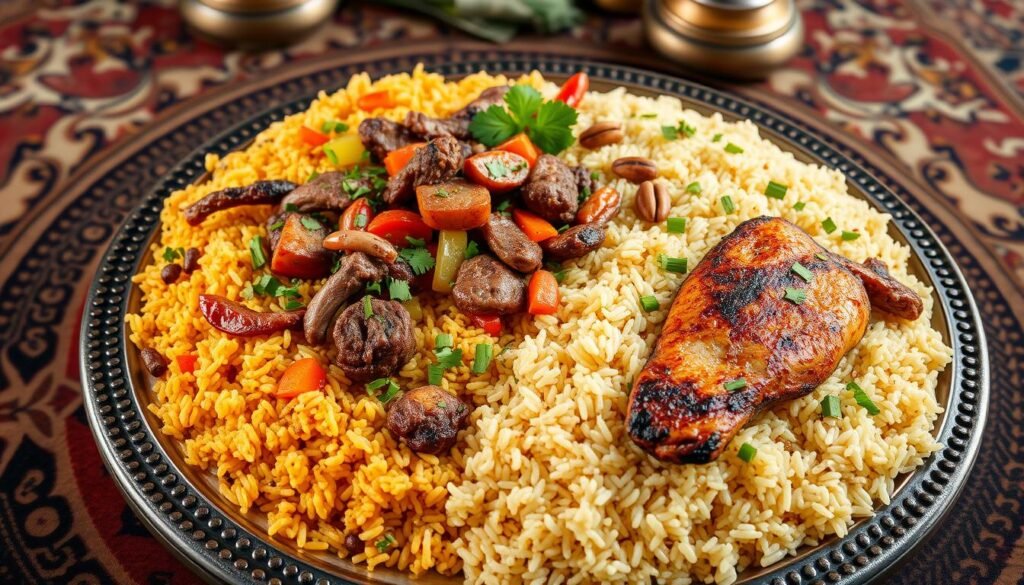
Trying Kabsa or Mandi lets you see the heart of Saudi’s food traditions. These dishes show off the kingdom’s spice blends and cooking methods. They invite everyone to explore the rich flavors of Saudi’s food heritage.
Traditional Saudi Breakfast Specialties
Explore the world of traditional Saudi Arabian breakfasts. Discover the flavors loved for generations. Saudi cuisine offers a journey of sweet and savory delights for every taste.
Sweet Morning Delicacies
Begin your day with Saudi’s sweet treats. Enjoy the flaky, buttery Maamoul, filled with dates, nuts, or cheese. Try the fragrant Luqaimat, sweet dumplings in syrup.
Also, try the creamy Hareesha. It’s a semolina porridge with honey, nuts, and dried fruits.
Savory Breakfast Options
Discover Saudi’s savory breakfasts. Try the Foul Mudammas, a fava bean stew with olive oil, lemon, and spices. Enjoy the fluffy Fatayer, a cheese-filled pastry.
Or, try the Ful Medames. It’s slow-cooked fava beans with garlic, cumin, and lemon.
Traditional Saudi Coffee Culture
No Saudi breakfast is complete without Saudi coffee. It’s a key part of Saudi culture. The coffee is made with traditional methods, offering a rich, aromatic taste.
It’s the perfect match for breakfast, bringing people together. It’s a symbol of Saudi hospitality and community.
Saudi Meat Dishes: A Journey Through Flavors
Explore the world of Saudi Arabian meat dishes. Here, spices, slow-cooking, and traditions blend into a flavorful symphony. From fragrant stews to succulent grilled dishes, Saudi cuisine is a true culinary adventure.
Saudi delicacies celebrate the humble yet flavorful cuts of meat. The tender lamb in Mandi and the juicy beef in Kabsa tell stories of Saudi’s rich heritage and love for traditional food.
Discover the variety of Saudi meat dishes, each with its own flavor and preparation. Try the slow-cooked Matazz lamb or the smoky Madbi grilled meat. These dishes showcase Saudi’s barbecue mastery.
As you explore Saudi Arabian meat dishes, you’ll learn about the region’s traditions. The fragrant spice blends and the importance of hospitality and shared meals are all part of the Arabic culinary experience.
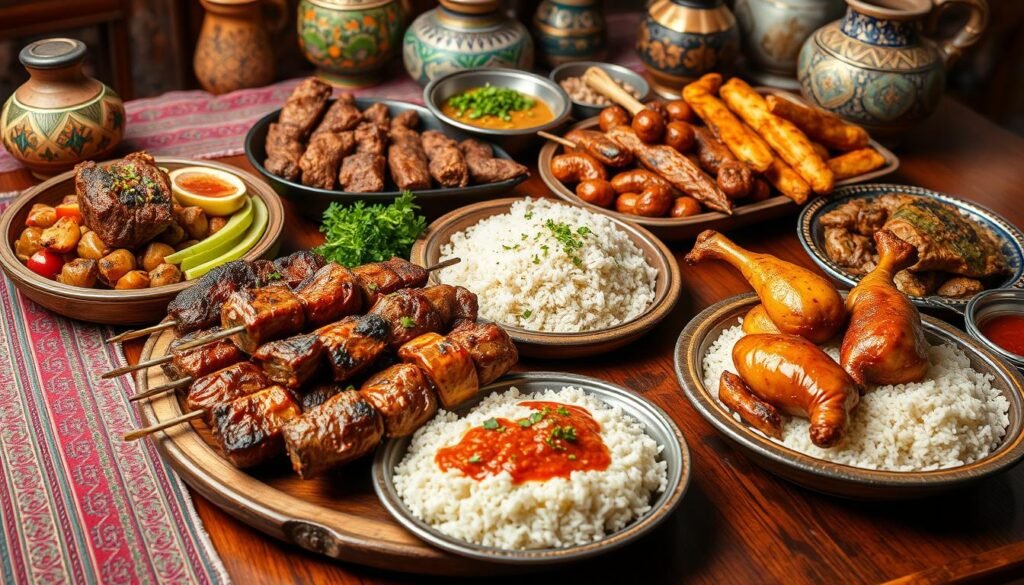
Start this culinary journey and let Saudi Arabia’s flavors enchant you. It will leave a lasting impression on your understanding of the region’s diverse culinary heritage.
Vegetarian Treasures of Saudi Cuisine
Saudi Arabia’s food scene is full of life, with both famous meat dishes and a wide range of vegetarian delights. Discover the plant-based wonders of Saudi cuisine. These dishes truly capture the essence of Middle Eastern food.
Legume-Based Dishes
Legumes are key in Saudi cooking, making many tasty and healthy meals. Mujadara is a mix of rice, lentils, and onions, full of flavor. Ful medames is a fava bean stew, loved for its rich taste. These dishes are made special with traditional spices and herbs.
Traditional Vegetable Preparations
The food in Saudi Arabia celebrates the area’s fresh produce. Vegetables are the stars in dishes like bukhari, a mix of roasted veggies with spices. Mishkak are grilled veggie skewers, showing off the Middle East’s vibrant tastes. These dishes show how versatile and rich Saudi vegetarian food can be.
Meat-Free Saudi Delicacies
Saudi cuisine also has many meat-free dishes for different diets. Try the creamy mutabbaq, a cheese and herb-filled pancake. Or enjoy the sambusak, pastry pockets filled with veggies. These dishes show the creativity and skill of Saudi chefs.
| Vegetarian Dish | Description | Ingredients |
|---|---|---|
| Mujadara | A hearty rice and lentil dish seasoned with aromatic spices | Rice, lentils, onions, garlic, cumin, coriander, olive oil |
| Ful Medames | A savory fava bean stew, often served for breakfast | Fava beans, onions, garlic, lemon juice, olive oil, spices |
| Bukhari | A medley of roasted vegetables seasoned with traditional spices | Eggplant, tomatoes, bell peppers, onions, garlic, spices |
| Mishkak | Grilled vegetable skewers, a popular street food | Zucchini, bell peppers, onions, mushrooms, olive oil, herbs |
| Mutabbaq | A savory pancake filled with cheese and herbs | Flour, eggs, cheese, parsley, mint |
| Sambusak | Delicate pastry pockets stuffed with a variety of vegetable fillings | Dough, vegetables (spinach, potatoes, peas), spices |
The vegetarian dishes in Saudi cuisine are a journey of flavors. From legume-based meals to vibrant veggies and meat-free treats, they celebrate the diversity and true tastes of Middle Eastern food.
Saudi Desserts and Sweet Delicacies
Explore the world of Saudi Arabian desserts and sweet treats. Here, traditional flavors meet time-honored recipes, delighting everyone. From date-based sweets to fragrant pastries, Saudi’s culinary scene is filled with amazing sweets. These show the country’s rich culture and the creativity of its chefs.
The date is a star in Saudi desserts. It’s known for its health benefits and versatility. Dates are used in delicious cakes, puddings, and pastries. Each bite is a mix of sweet fruit, spices, nuts, and cream.
Saudi pastries are also famous. They’re filled with nuts, cream, or cheese. These pastries are flavored with rose water, cardamom, and saffron. They offer a mix of textures and tastes.
Trying these desserts is more than just eating. It’s a way to experience Saudi’s rich food culture. Whether it’s a creamy milk pudding or a crunchy baklava, each bite tells a story of Saudi’s Arabic culinary traditions.
- Dates-based confections
- Fragrant pastries
- Creamy milk puddings
- Nut-filled delicacies
Street Food Culture in Saudi Arabia
Saudi Arabia’s street food scene is vibrant and full of authentic flavors. It shows the rich culinary heritage of the Middle East. From big cities to small towns, the street food here is diverse. Each dish reflects the country’s many influences.
Popular Street Food Locations
In Riyadh, the capital, Deira Souq and Jeddah’s Al-Balad district are key spots for street food. People from all over come here. They enjoy the smells of food and the lively talks of vendors.
Must-Try Street Food Dishes
- Shawarma: Fragrant, slow-roasted meat wrapped in flatbread with crisp vegetables and tangy sauces.
- Falafel: Crispy, deep-fried balls of chickpeas, herbs, and spices, often served in pita bread with refreshing accompaniments.
- Qishta: A creamy, custard-like dessert made with milk, sugar, and rose water, topped with crunchy nuts.
Modern Street Food Innovations
A new wave of chefs and entrepreneurs is changing Saudi street food. They offer gourmet food trucks and fusion street food stalls. These innovators show the creativity and adaptability of Saudi cuisine.
| Traditional Saudi Street Food | Modern Saudi Street Food Innovations |
|---|---|
| Shawarma | Gourmet Shawarma Wraps with Unique Fillings |
| Falafel | Fusion Falafel with Global Flavor Profiles |
| Qishta | Artisanal Qishta Desserts with Experimental Toppings |
Traditional Saudi Dining Etiquette
Diving into Saudi cuisine is more than just tasting amazing food. It’s a deep dive into the Arabic culinary experience. Here, I learn about the respect for hospitality and the social norms that shape traditional Saudi food.
In Saudi dining, community and shared meals are key. Meals are served family-style, with everyone joining in. It’s a time for lively talks and bonding over food.
Table manners in Saudi Arabia are unique. The right hand is for eating, while the left is for other tasks. Using bread to scoop food shows the resourcefulness of traditional Saudi food.
FAQ
What are the must-try Saudi Arabian dishes for food enthusiasts?
Food lovers will find a world of flavors in Saudi Arabian cuisine. Must-try dishes include Kabsa and Mandi, known for their rice. There are also flavorful meat dishes and traditional breakfasts. Each dish offers a unique taste of Saudi cuisine.
How has the history and cultural heritage influenced Saudi Arabian cuisine?
Saudi Arabian cuisine has a rich history and cultural heritage. The country’s geography and cross-cultural exchanges have shaped its flavors and cooking methods. This heritage adds depth to the dining experience, showing the country’s hospitality and traditions.
What are the essential ingredients used in Saudi Arabian cooking?
Key ingredients in Saudi cooking are rice, dates, lamb, and spices. These ingredients add unique flavors and hold cultural significance. They are essential for creating authentic Saudi dishes.
Can you tell me more about the traditional cooking methods in Saudi Arabian cuisine?
Traditional cooking methods are crucial in Saudi cuisine. Techniques like Shuwa and spice blends create distinct flavors. These methods highlight the essence of Saudi gastronomy.
What are some of the most iconic rice dishes in Saudi cuisine?
Kabsa and Mandi are iconic Saudi rice dishes. They combine fragrant rice, tender meat, and spices. These dishes are a true taste of Saudi culinary tradition.
What are the must-try traditional Saudi breakfast dishes?
Saudi breakfasts are a delightful mix of sweet and savory dishes. Date-based confections and savory preparations are highlights. Rich coffee traditions enhance the experience, showing the importance of family and friends in Saudi culture.
What are some of the popular meat dishes in Saudi cuisine?
Meat dishes are a big part of Saudi cuisine, showcasing its diversity. From stews to grilled specialties, these dishes highlight Saudi’s culinary skills. Exploring these dishes is a flavorful journey through Saudi culinary culture.
Are there any noteworthy vegetarian options in Saudi cuisine?
Yes! Saudi cuisine has a variety of vegetarian dishes. Legume-based dishes and vegetable preparations are highlights. These dishes show the creativity and nutritional value of plant-based ingredients in Saudi cuisine.
What are some of the must-try Saudi Arabian desserts and sweet delicacies?
Saudi desserts and sweets are a must-try. Dates, pastries, and puddings are highlights. These sweets offer a delightful end to any meal, showcasing Saudi’s rich cultural heritage and culinary artistry.
Can you tell me more about the street food culture in Saudi Arabia?
Saudi street food offers a unique glimpse into its culinary traditions. From popular spots to must-try dishes, it reflects both tradition and modernity. Exploring street food deepens appreciation for Saudi’s diverse flavors and communal dining.
What are the traditional dining etiquette customs in Saudi Arabia?
Knowing Saudi dining etiquette is key to an authentic experience. These customs include manners and cultural practices. They provide insights into Saudi’s hospitality traditions, celebrated in its gastronomy.
Don’t forget to share your experience in the comments and follow us on social media at the bottom of the site.

